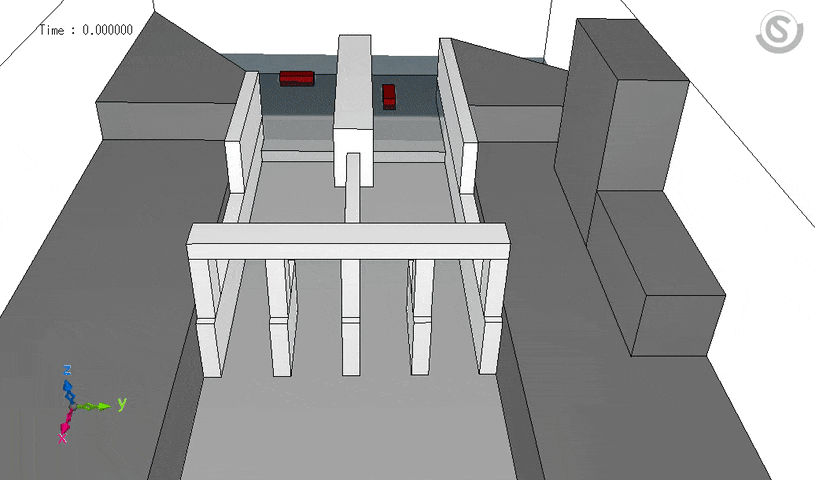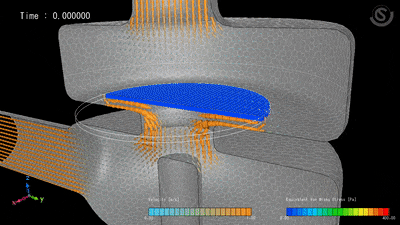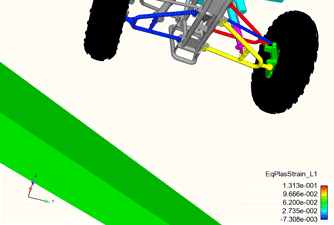MSC Co-Simulation - where Multiphysics gets Real
Co-simulation provides engineers with a unique, more complete & holistic performance insight by coupling together multiple simulation disciplines. Everything from acoustics to multibody dynamics (MBD), Aerodynamics , hydrodynamic vibration, complex heat transfer, to structural analysis, and explicit crash dynamics can be connected together in MSC.


MSC Co-Simulation Technologies
Depending on the type of analysis, engineers can use MSC solutions in two ways – Co-Simulation (applying multiple physics to the model simultaneously) or Chained Simulation (passing load case results from one analysis to the next).
MSC CoSim Engine
The MSC CoSim Engine has been developed in order to provide a co-simulation interface for the direct coupling of different solvers/disciplines with a multi-physics framework. This first version, readily available today, enables engineers to set up co-simulation models between Adams, Marc, MSC Nastran and scFLOW.
Other Open Co-Simulation Solutions
Besides the CoSim Engine, MSC also supports a list of other co-simulation methodologies, including the Functional Mock-up Interface (FMI), Adams Marc Co-Simulation Interface (ACSI) and so on.

Chained Simulation
Chained simulation allows CAE engineers from different departments to integrate multiple disciplines sequentially and improve the overall simulation accuracy. For example, passing the road loads data from an Adams Full Vehicle model to the downstream MSC Nastran model for the stress & durability analyses.













WE WORK WITH YOU
We pride ourselves on empowering each client to overcome the challenges of their most demanding projects.
Enteknograte offers a Virtual Engineering approach with FEA tools such as MSC Softwrae(Simufact, Digimat, Nastran, MSC APEX, Actran Acoustic solver), ABAQUS, Ansys, and LS-Dyna, encompassing the accurate prediction of in-service loads, the performance evaluation, and the integrity assessment including the influence of manufacturing the components.
Integrated Artificial Intelligence (AI) & Machine Learning - Deep Learning with CFD & FEA Simulation
1D/3D Coupled Simulation and Co-Simulation: Detailed Chemistry & Multiphase Flow Modeling with 1D Modeling
Hydrodynamics & HydroAcoustics simulation for AIV (Acoustic Induced Vibration)
Ship Stability & Safety Analysis Including Hydrodynamics & Aerodynamics Effects
Cavitation in Propulsion Systems
Hydrodynamic Performance of Ship Hull: CFD Based Design
Hydrodynamics CFD simulation, Coupled with FEA for FSI Analysis of Marine and offshore structures
Floating, Fixed & Gravity-Based Structures Design Including Hydrodynamics & Aerodynamics Effects
Hydropower, Solar Power and Biomass
Structural Dynamics Integrity & Vibro-Acoustics Simulation for Marine & Shipbuilding Industry
Hydroplaning (Aquaplaning) Simulation
Turbine, Pump & Compressor (Axial or Centrifugal)
Integrated Artificial Intelligence (AI) & Machine Learning - Deep Learning with CFD & FEA Simulation
Electromagnetic Multiphysics
Acoustics and Vibration
Aerodynamics Simulation: Coupling CFD with MBD, FEA and 1D-System Simulation
Fatigue Analysis of Welded Structures Using the Finite Element Method
Finite Element Analysis of Durability and Fatigue Life
Heat Transfer and Thermal Analysis
Multi-Phase Flows CFD Analysis
NVH & Acoustics for Hybrid & Electric Vehicles
eVTOL (Electric Vertical Take-Off and Landing) & UAM (Urban Air Mobility)
Finite Element Simulation of Crash Test and Crashworthiness with LS-Dyna, Abaqus and PAM-CRASH
Acoustics and Vibration: FEA and CFD for AeroAcoustics, VibroAcoustics and NVH Analysis
Aerodynamics Simulation: Coupling CFD with MBD, FEA and 1D-System Simulation
Vehicle Thermal Management Simulation
Finite Element Analysis of Durability and Fatigue Life
Multibody Dynamics
Additive Manufacturing and 3D Printing
Heat Transfer and Thermal Analysis: Fluid-Structure Interaction with Coupled CFD and Finite Element Based Simulation
WE WORK WITH YOU
We pride ourselves on empowering each client to overcome the challenges of their most demanding projects.
Enteknograte offers a Virtual Engineering approach with FEA tools such as MSC Softwrae(Simufact, Digimat, Nastran, MSC APEX, Actran Acoustic solver), ABAQUS, Ansys, and LS-Dyna, encompassing the accurate prediction of in-service loads, the performance evaluation, and the integrity assessment including the influence of manufacturing the components.





